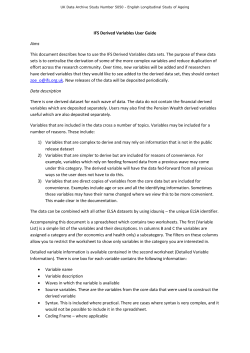
HILDA Top-up Sample in Wave 11 Nicole Watson
HILDA Top-up Sample in Wave 11 Nicole Watson HILDA Deputy Director, Survey Methodology Why have a top-up top up sample? Current HILDA sample selected in 2001 (n=7800 households) – Initial sample followed (Permanent Sample Members) – ‘Following rules’ add others to the sample • Births to PSMs • Other parent of births to PSMs • Immigrants arriving after 2001 (from wave 9) First top-up in 2011. Why? – Undercoverage of population due to immigration – Various options canvassed in 2006 and decided on general top-up • ‘Refresh’ Refresh the ongoing sample sample. Allows us to compare characteristics of samples and study cumulative effect of attrition • Larger combined sample size (n=7300+2000 households) www.melbourneinstitute.com Undercoverage over time (% Australian population) www.melbourneinstitute.com Top-up Top up sample design Select 3250 d dwellings, ellings 8% out o t of scope, scope 66% response = 2000 responding households Similar sample design as wave 1 3-stage clustered design – Stage 1: 125 Census Collection Districts with probability b bilit proportional ti l tto size i ((number b occupied i d dwellings from 2006 Census) – Stage g 2: Approx. pp 24 in-scope p dwellings g selected in each CD – Stage 3: Up to 3 households selected in each dwelling www.melbourneinstitute.com Overlap of the underlying populations www.melbourneinstitute.com Face-to-face Face to face interviewers Experienced E i d HILDA interviewers New-to-HILDA interviewers Total interviewers Both ongoing and top-up p p 70 5 75 Ongoing only 50 15 65 p p only y Top-up 5 0 5 Wave 11 total 125 20 145 Wave 10 total 117 15 132 Sample www.melbourneinstitute.com Training schedule July Aug Sept Period 1 Oct Nov Dec Period 2 Jan Feb Period 3 Top-up Ongoing W10 Training Fieldwork www.melbourneinstitute.com Questionnaire design Household Form similar to wave 1 – – – – – Name, sex, date of birth E li h llanguage ability English bilit Employment status Long term health condition Relationships Dwelling e g obse observations a o so on first approach – type of dwelling – external condition of the dwelling – likelihood that dwelling contains children under 15 – presence of security features • • • • • locked gate security guard / doorman security door dangerous dog no junk mail / hawkers sign • grab rails / ramp access • bars on windows • roller shutters – condition of the garden – type yp of road the dwelling g is on www.melbourneinstitute.com Questionnaire design, cont’d cont d Household H h ld Q Questionnaire ti i – same as ongoing i W11 Person Questionnaire – excludes – Section L on retirement – Section M on intentions and plans – Parts of Section G on family formation • G27 to G67 on caring for children, grandchildren, and desires and preferences for more children – Section E on other labour market activity Self-Completion Questionnaire – same as ongoing W11 melbourneinstitute.com/hilda/questionnaires/q11.html www.melbourneinstitute.com Interview length 60 50 Miinutes 40 30 Age <=19 Age 20+ 20 10 0 1 2 3 4 5 6 7 8 9 10 Wave www.melbourneinstitute.com Respondent material www.melbourneinstitute.com Weighting methodology Two approaches – Combine estimates – identify which minimises variance for combined estimate ( yorig + (1- ) ytopup) of key variable • Choice of key variable or average across several • Weights more variable – Pool samples – probability of selection • Need to know probability of individual being selected in sample they were not selected in • Weights are less variable www.melbourneinstitute.com Weights to be provided Release 1 2 3 … 10 11 12 13 14 Crosssection 2 3 … 10 11 12 13 14 1-2 1-3 2-3 … … … 1-10 2-10 1-11 2-11 10-11 10 11 1-12 2-12 10-12 10 12 11-12 1-13 2-13 10-13 10 13 11-13 12-13 1-14 2-14 10-14 10 14 11-14 12-14 13-14 1&2 1&3 2&3 … … … 1&10 2&10 1&11 2&11 10&11 1&12 2&12 10&12 11&12 1&13 2&13 10&13 11&13 12&13 1&14 2&14 10&14 11&14 12&14 13&14 1 Longitudinal Continuous Pair Red=Includes top-up www.melbourneinstitute.com Timeframe for top-up top up Activity y Time Sample selection and preparation Oct 2010 – Jun 2011 Fieldwork July 2011 – Mar 2012 Technical paper on survey design Sept 2011 Data preparation Apr - Nov 2012 Data release Nov 2012 Technical paper on weighting methodology gy Nov 2012 Discussion paper on comparison of ongoing and top-up samples Dec 2012 www.melbourneinstitute.com
© Copyright 2025



















